It is near-universal that fantasy managers prioritize the league’s few remaining bell-cow running backs on draft day.
This strategy makes sense for a simple reason: there is a very limited stable of truly elite running back talents with a seemingly guaranteed high-volume workload. Their high total point contribution, scarcity of top-end production, and relatively predictable contributions give confidence to league managers fortunate enough to draft at the top end of the first round.
But what if you’re on the back end? Not having one of those select few running backs can leave a team at a significant disadvantage before the draft’s first round even ends.
Question marks begin to emerge among the players left on the board, and confidence in potential selections plummets, especially considering the relative ease of finding wide receiver value in the later rounds.
Your first draft pick is the most important of the year. You want proven production, relative value, and a consistent set-and-forget producer.
So where should you look if your running back and wide receiver darlings are off the board and the remaining options bring more questions than answers? Tight end.
Point Contribution
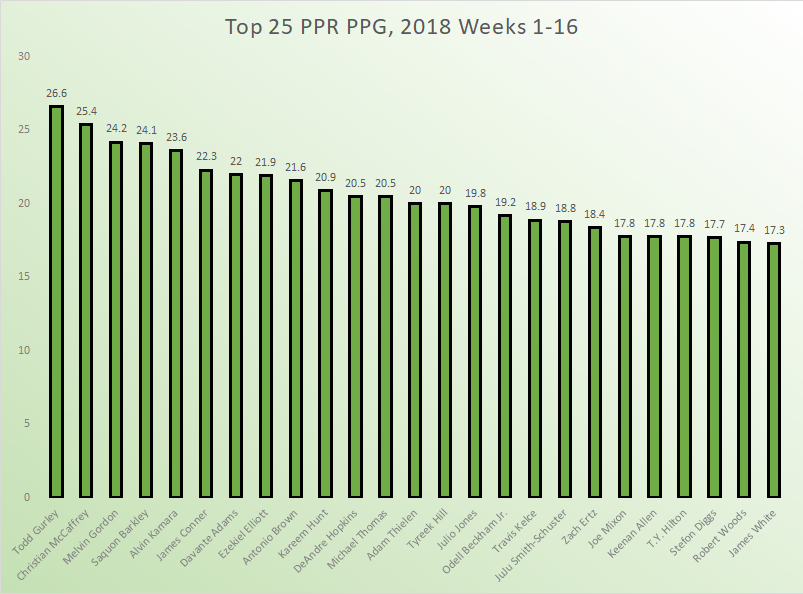
The above graph displays the top 25 non-quarter back point-per-game (PPG) finishers from 2018’s weeks 1-16 (I’ll be excluding week 17 from all data analysis in this article; you should advocate ending your fantasy season in Week 16 if you haven’t already). Note that tight ends Travis Kelce and Zach Ertz finished among premier talented wide receivers and running backs such as Mike Evans and Joe Mixon.
Had either Kelce (18.9 PPG) or Ertz (18.4 PPG) been a running back, they would have finished as the RB 10 in PPG, just below Kareem Hunt and above big-name running backs like Joe Mixon, James White, and David Johnson. As wide receivers, Kelce would have finished as the WR 9 in PPG above Juju Smith-Schuster, and Ertz would have been WR 10 above the likes of Keenan Allen and T.Y. Hilton.
In a vacuum that is relatively impressive, but it’s hardly enough to justify picking an elite tight end talent with your first draft pick.
Production Cliff
The reason that Quarterbacks are often reserved for late-round draft picks by fantasy football enthusiasts is due to the simple fact that the top end quarterbacks typically have relatively close and unpredictable positional finishes, and teams in need of QB help can quickly find a relatively suitable replacement on the waiver wire. It simply doesn’t make sense to invest high draft capital in a player whose fantasy production is not only extremely unpredictable but can also be replaced by a considerably later pick.
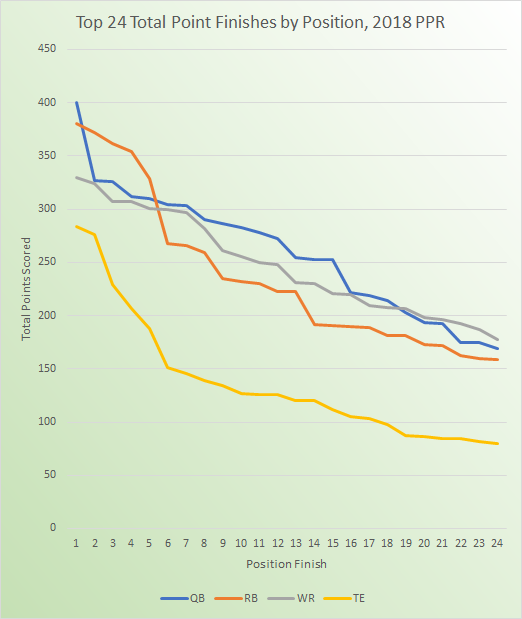
The above graph plots positional ranking versus total points scored for quarterbacks, running backs, wide receivers, and tight ends in 2018.
For years, the drop off in production after the top handful of relatively predictable bell-cow running backs has been used to justify their high Average Draft Positions (ADPs). As expected, we can see that there is a huge immediate decline in season-long point totals after the few elite running back finishers, but the drop off exists for tight ends as well.
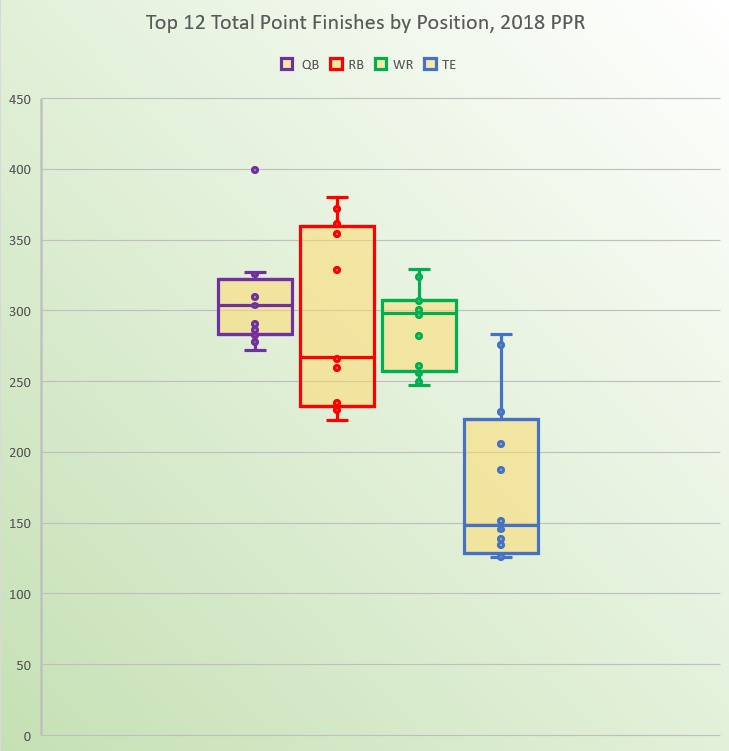
Above, we’re looking at the top 12 finishes at each position (because your league will probably only have about 12 Tight Ends rostered anyway). The top hash on each box plot represents the top scorer at the position (except for quarterback, for which Patrick Mahomes was still an outlier), while the bottom hash represents the 12th finisher.
Again we see that tight end sees a production drop off (as evidenced by the distance between the top and bottom hashes) similar to that of running backs, while the top quarterbacks and wide receivers have closer finishes.
Below we can see the 2018 PPG splits between top-end options at each position and their later potential replacements on your roster.
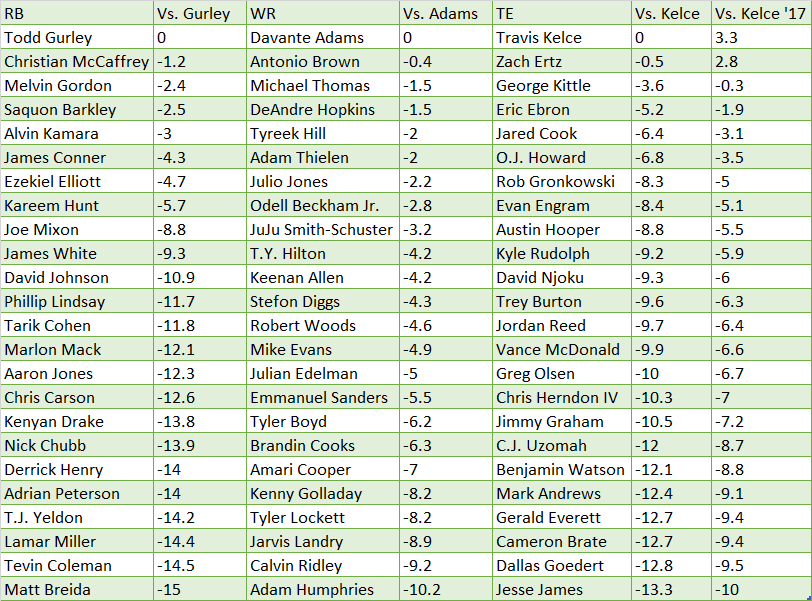
Since Kelce’s offense may be bound for some regression, I included his 2017 PPG with Alex Smith as his QB as well.
Something to keep in mind: The difference between Kelce’s PPG and Eric Ebron‘s (who was 4th in PPG among top-24 TE finishers) is the same as the difference in PPG between Joe Mixon and Adrian Peterson. The difference between Kelce and 5th PPG finisher Jared Cook was 0.1 PPG more than the difference between Davante Adams and Brandin Cooks.
The point is this: if you miss on a top-end TE, you lose production that won’t be easy to make up elsewhere.
Tight End Volatility
Tight End finishes have been wildly inconsistent over the past three seasons, with one obvious exception.
Here are the top 12 TE finishers in total points scored, PPR, weeks 1-16 in 2016:
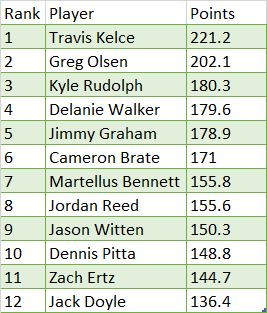
…and 2017:
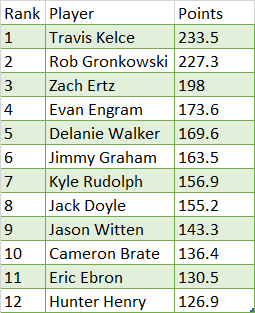
…and 2018:
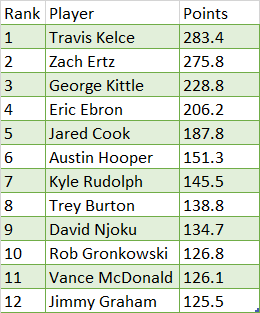
The exception to the rule of Tight End unpredictability?
Travis Kelce.
Kelce has finished as the TE1 in total points scored for three consecutive years.
Had he been a running back, he would have finished:
RB 9 in 2016.
RB 8 in 2017.
RB 6 in 2018.
(PPR, Weeks 1-16)
You have the ability to add near-guaranteed low-end RB1 numbers to your TE slot. All it takes is adding Travis Kelce to your roster.
The Investment
Travis Kelce’s PPR ADP projects him as a mid-2nd round pick according to Fantasy Football Calculator. A first-round investment may be pegged as a reach on draft day, and that’s okay. If you’re sitting at the back end of the first, you probably aren’t getting one of the most elite running backs or wide receivers anyway, and Kelce is almost guaranteed a lock for another #1 TE finish with back end RB1/WR1 fantasy numbers.
If you’re drafting at the tail of the first round, it’s a very real possibility that someone beats you to the punch on Kelce before your second pick. If you miss Kelce, you’ll take on a bit more risk if you decide to invest in the other “Big 3” Tight Ends, Zach Ertz or George Kittle.
While Ertz is often mentioned in the same breath as Kelce during the “Big 3” TE conversation, Dallas Goedert’s potential to cut into his volume has made his ADP a little easier to swallow, and he will almost certainly be available when your second-round pick rolls around.
George Kittle only made his way into the “Big 3” conversation last year, but the return of Jimmy Garoppolo bodes well for his fantasy production in 2019, and he demonstrated plenty of athletic and big-play ability during his second NFL season.
Still, many will argue that you can simply stream your tight end spot instead of investing big-time draft capital on a “onesie” position.
Streaming adds another layer of guesswork to an already unpredictable game, especially when considering a position as volatile as tight end. I’m personally a huge fan of set-and-forget production, and a top tight end provides it in spades.
Others will say there’s more value to be had by waiting on a guy like O.J. Howard, but, again, the position is traditionally very unpredictable. Banking on a breakout may be enticing, but you’re left at a disadvantage if it doesn’t come to be. Howard’s competition for targets in Mike Evans and Chris Godwin is nothing to scoff at either.
While they may be pegged as a reach if taken in the first two rounds of your 2019 fantasy draft, Kelce, Ertz, and Kittle all offer tremendous upside with very high floors at an extremely limited and volatile position.
What’s the Point?
Come draft day, you may find that the elite running back and wide receiver options are off the board when your first pick comes around. The production numbers and history of fantasy tight ends suggest that The Big Three are justified at their current ADPs, and investing one of your first two picks to guarantee you have Kelce, Ertz, or Kittle on your roster may not be a bad idea.
I know what you’re thinking…
https://gfycat.com/highconcernedcanadagoose
Just make sure you have thick skin.
Featured image by Justin Paradis (@freshmeatcomm on Twitter)